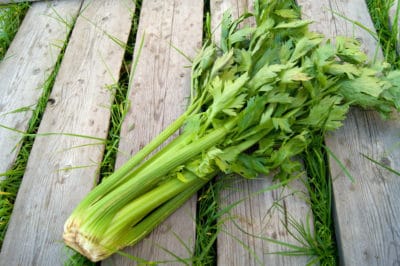Growing Celery
Growing good celery can be a little tricky. It demands nutrient-rich soil that also drains well. Add lots of organic humus in the form of aged manure, compost or leaf mold, as well as some organic 5-10-10 fertilizer. Descended from swamp plants, celery also needs plenty of water. Short it on moisture and you’ll harvest stringy, bitter stalks. Finally, plant it in full sun if at all possible.
Choosing Varieties
Celery varieties are more numerous than you might expect. There are red and yellow varieties, as well as varieties grown strictly for seed or cutting.
- Tall Utah 52-70R – typical dark green stalk celery.
- Zwolsche Krul – Dutch heirloom used as a strong-flavored cutting celery.
- Redventure – green stalks have red interiors.
- French Dinant – good for harvesting individual stalks.
- Smallage – celery ancestor used for culinary celery seed.
Harvesting Celery Plants
Celery plants have a long growing season and are typically ready to harvest about 85 to 120 days after transplanting. It’s best to harvest before temperatures get hot, as this can make for bitter, stringy stalks. Water soil well before harvest. Loosen the soil around the plant, grasp it firmly with both hands close to the base and pull out of the ground with a twisting motion.
Harvesting Celery Stalks
Although you can harvest a few stalks at any time, some varieties, such as French Dimant, really lend themselves to this technique. Use a sharp knife and cut the stalk about two inches above soil level. Just in case of disease, disinfect the knife with alcohol and rinse with water before going on to another plant. Keep an eye on the cut stalks for signs of rot.
Harvesting Celery Leaves
Cutting celeries have a lot more leaf than table celery, as well as much thinner stems. The leaves are used as a flavoring in stews, soups and other recipes rather than for fresh eating. These can be harvested as a whole plant as you would stalk celery. You can also cut individual stalks and leaves, using similar techniques to those used for harvesting individual stalks.
Harvesting Celery Seeds
Celery is a biennial, so you can’t harvest seeds until the second spring. You can harvest to obtain seeds to plant or for culinary use. Allow the seed umbels to dry on the plant until the seeds begin to turn brown, then strip off the ripe seeds. The remaining seeds will ripen and can be harvested later.
